BAD HAIR (2020)
In 1989 an ambitious young woman gets a weave in order to succeed in the image-obsessed world of music TV. However, her new hair may have a mind of its own...
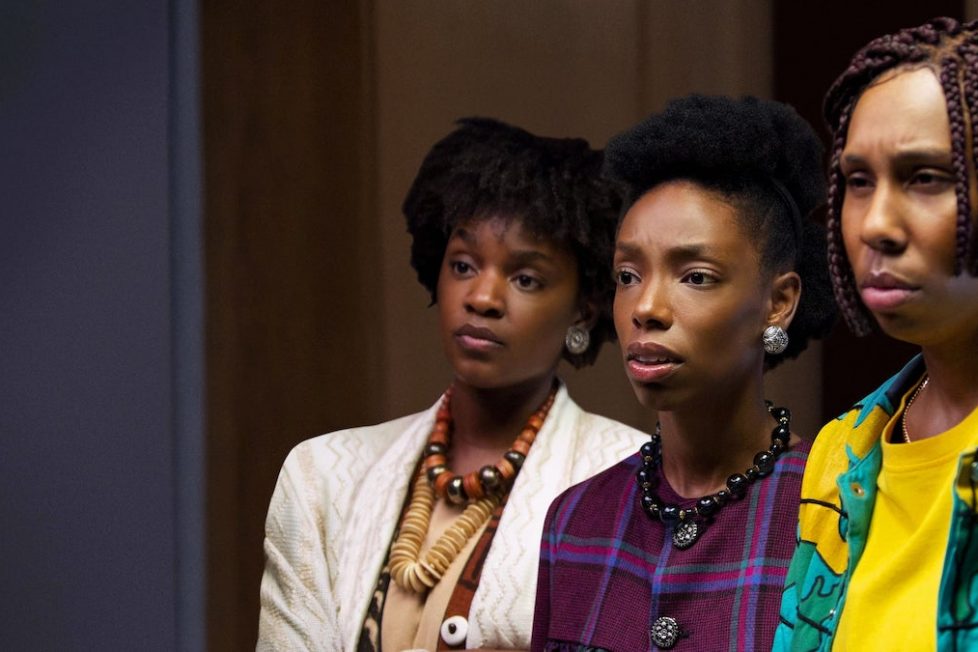
In 1989 an ambitious young woman gets a weave in order to succeed in the image-obsessed world of music TV. However, her new hair may have a mind of its own...


Writer-director Justin Simien is a bold and ambitious filmmaker whose work brims with an assortment of concepts. His feature debut, Dear White People (2014), was a colourful satire about black millennial anxieties on a predominantly white college campus. His symmetrical compositions and on-screen text echoed that of Wes Anderson (Moonrise Kingdom); whereas his authorial voice of racism, sexuality, and micro-aggressions was a composite of early Spike Lee (Do the Right Thing). The result was a feature admirably packed with ideas and vision. Following great reviews and accolades during its premiere at the 2014 Sundance Film Festival, the director’s critically acclaimed debut grossed over $5M on a budget of $1M during its limited theatrical run.
In 2017, Simien signed with Netflix to adapt Dear White People into a television series, allowing more time and space to expand the character development and explore social conventions. Upon returning to Sundance Film Festival in 2020, Simien once again pushes the envelope with his sophomore effort, Bad Hair. Working with a budget of $8.9M, the filmmaker has graduated to grander aspirations, lending his satirical eye to supernatural horror blended with thought-poking commentary. The director gives an incredible insight into the pressures black women have experienced over the decades due to their natural hair. Bad Hair mindfully constructs equally thoughtful and relevant social dynamics drawing parallels between School Daze (1988) and They Live (1988).
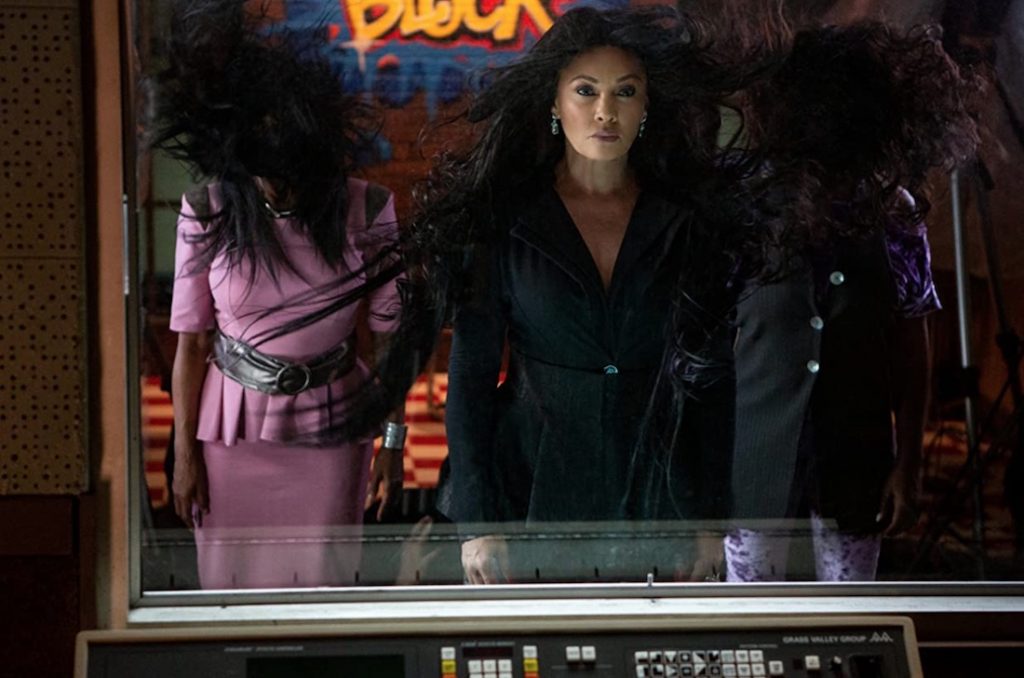
During the rise of New Jack Swing in 1989, Anna (Elie Lorraine) is an assistant working at the music TV station “Culture”. After channel executive Grant Madison (James Van Der Beek) makes some changes, her dreams of a promotion turn sour. And when her new boss, Zora (Vanessa Williams), arrives to revamp the network, she suggests she may be interested in Anna’s ideas if she changes her image. At the risk of losing her job, Anna goes to the most popular hairstylist in the city for a new weave. The result is transformational and Zora promotes Anna to associate producer status on a brand new TV show. However, the salon’s clients all suffer from something sinister in their weaves…
In her first leading role, Ellie Lorraine (Insecure) commands the screen with a performance that’s a labyrinth of complexity. As Anna, she successfully showcases various different personalities to her character; seamlessly portraying her as sweet, charming, terrified, seductive, and intimidating once her weave possesses her. Lorraine’s expressive eyes encapsulate Anna’s harrowing journey and she imbues her character with insecurities through a hunched posture and timid demeanour. However, once the supernatural forces cast a dark spell over Anna, the actress dominates the screen with hellacious fury. Her incredible transformation keeps the audience invested, infusing the right amount of heart and humour. The ability Lorraine displays shifting from a doe-eyed, ambitious young woman, to a domineering figure empowered by her new hair is breathtaking to behold.
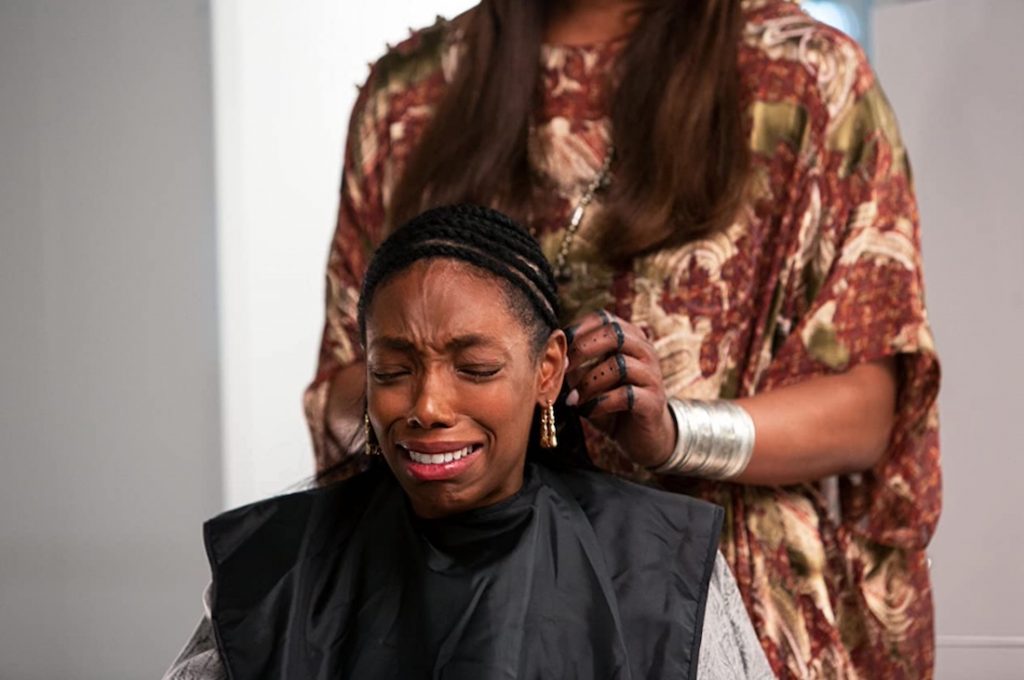
The supporting cast is equally impressive. Vanessa Williams has proved several times she’s capable of portraying a powerhouse woman, and her character here’s no exception—she’s deliciously catty and calculating as the new channel executive Zora. Similar to her devious Wilhelmina Slater character in Ugly Betty (2006-2010), she throws around wonderful insults and shade, to strike the exact right notes once the films hits its campy horror stride. The 1990s was a flourishing decade for Williams, who was a chart-topping artist with the song “Save the Best for Last”. Personally, it’s refreshing to see her step back into the era portraying a stern executive. Additionally, Lena Waithe (Queen & Slim) makes the most of her presence as the comic relief Brook-Lynne. Adding hilarious satire to the proceedings, she delivers some hilarious lines even when she’s running for her life (“Look, I cannot die today okay? I haven’t been to church in like 15 years”). Her comedic timing comes alive once the horror takes over.
As a director, Simien perfectly expresses his feelings towards the cultural oppression that black women have been subjected to for centuries. The constant judgment, lack of equal opportunities, toxic work environment, and generification are several issues seamlessly weaved into his story. Anna’s decision to change her hair isn’t really her choice. It’s an obligation to a societal beauty standard that black women are held to succeed. Similar to Sorry to Bother You (2018), Anna’s tricked into becoming her own oppressor, all in the name of fitting in with societal expectations of beauty. The most powerful statement comes from Anna’s uncle, Amos (Blaire Underwood): “from the moment you were born. You were so thoroughly indoctrinated by the insanity of Western European worldview that you can’t bear to see yourself the way nature would have”. Admittedly, the absurd sounding premise of a murderous hair weave evokes memories of the “Hell Toupee” tale featured a Treehouse of Horror episode of The Simpsons. However, Simien prevails in making Bad Hair’s message work.
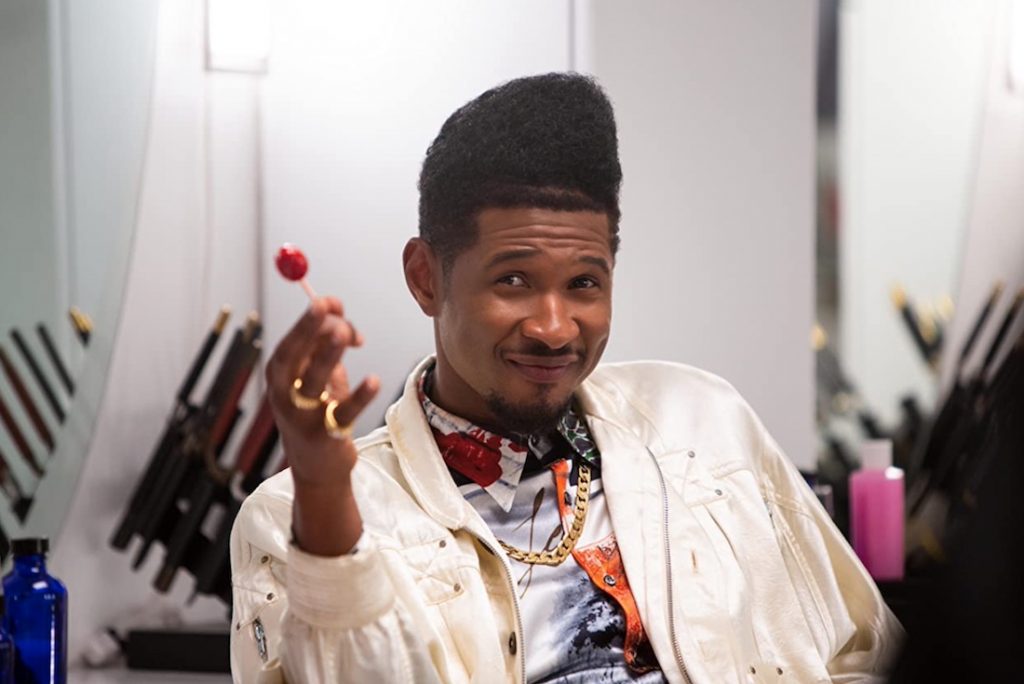
Beginning as an interesting drama about black woman’s plight in trying to succeed within the burgeoning TV industry, Bad Hair works best when it explores campy horror. Once the story leans into supernatural territory, Simien borrows elements from Invasion of the Body Snatchers (1978) and Stepford Wives (1975). Tony Gardner’s (Zombieland: Double Tap) pulpy practical effects deliver exciting shocks and thrills that’ll appeal to fans of classic Sam Raimi (Evil Dead). The director’s love for 1980s B Movie horror contains similar manic energy as Brian De Palma (Carrie). At the sight of blood, Anna’s bloodthirsty weave extends its thick tendrils to soak up nourishment. And the eerie visual of black hair smothering its victims pays homage to Korean and Japanese horrors, including The Wig (2005) and EXTE: Hair Extensions (2007). However, the scariest scenes are not of any of the hair murders, it’s the experience of getting a hair weave itself.
While Simien doesn’t lean too heavily into gory horror, there are certainly hints of David Cronenberg (Videodrome) and Larry Cohen (The Stuff). The traumatic opening scene sets the tone for the more intense explorations of body horror. During the prologue, we see a teenage Anna suffer a nasty burn from a chemical, in an attempt to remove the natural kinks and curls from her hair. The director’s use of sound design during the introduction is visually and audibly frightening. In a later scene, Anna visits Virgie’s (Laverne Cox) salon for hair extensions. “I don’t usually let people touch my hair” she demurs, running her fingers across the thick scar on her head. The sequence of Anna enduring excruciating pain as her new weave is attached to her scalp is cleverly captured and equally painful to witness. The close-ups of needles penetrating her flesh and rows of bloody follicles as they’re violently pulled and twisted will have many viewers clutching their heads.
Simien does an exceptional job of maintaining a strange and unnerving atmosphere. Bad Hair feels like it takes place in an alternate dimension that’s close to reality, but slightly dissonant. Akin of Control-era Janet Jackson, singer Kelly Rowland makes an appearance as the latest hip-hop sensation, Sandra. Admirably, the director even takes the time to craft a complete ’80s music video for her latest single. Similar to the hilarious TV spoofs in Dear White People, these creations mainly appear in the background creating a certain depth. However, the most uncomfortable sequence takes place when Anna first arrives at Virgie’s hair salon. The director plays with insidious camera angles and slow zooms as our protagonist walks through a hall of hair samples. Combined with Kris Bowers’ (Green Book) malevolent score, the unsettling ambiance echoes of Peter Strickland’s surreal horror In Fabric (2018).
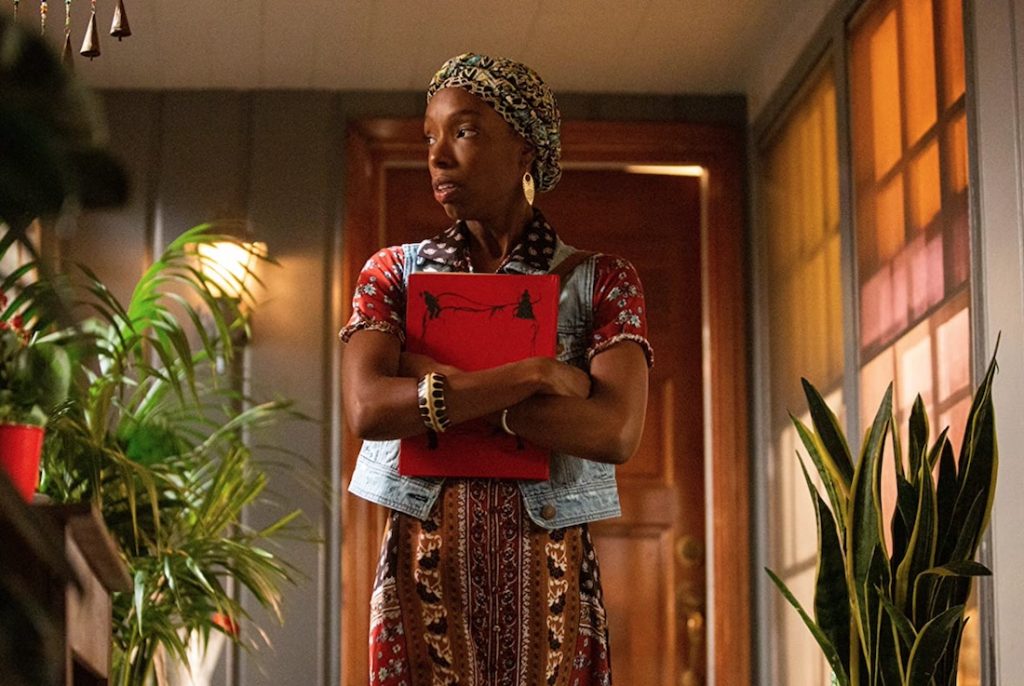
In addition to the skillful and stylish direction, Simien perfectly captures the trends of the late-’80s. The remarkable production design from Scott Kuzio (Christine) sparkles with detail and feels like a time capsule of the decade. Office desks are lined with vintage Apple computers as retro TV sets display Culture’s ’80s MTV-esque programming. Costume designer Ceci also captures the decade’s fashion perfectly, placing each character in different styles representing their personalities. Executives are dressed in power-suits complete with large shoulder pads, whereas Brook-Lynn wears ’80s tracksuits akin to Run DMC. Dear White People cinematographer, Topher Osborn, truly enhances Bad Hair’s low-budget horror aesthetic. It’s a personal preference, but I admire Simien’s decision to capture all of the action on 16mm. The natural grain stylistically mimics the likes of Frank Henenlotter (Brain Damage) and John Carpenter (The Fog).
As entertaining as the dialogue and performances are, Bad Hair isn’t without some flaws. Thematically, Simien has a lot to express regarding the psychological impact of beauty and identity within black communities. Unfortunately, with a runtime of almost two hours, Bad Hair suffers from several split ends that could’ve been left on the cutting room floor. The provocative subtexts become somewhat puzzling as the director attempts to introduce a haphazard folklore backstory during the third act. The mythology Anna unnaturally finds herself drawn to is the tale of “The Moss Haired Girl”; an urban legend about a slave woman who fashions herself a wig from the moss that grows on trees. However, the semi-explanation of the source of the cursed hair lacks a satisfying revelation to Anna’s circumstances. The director’s vague connection to slavery lacks the crystal-clear precision of Jordan Peele’s Get Out (2017). Ultimately leaving audiences with more questions than answers.
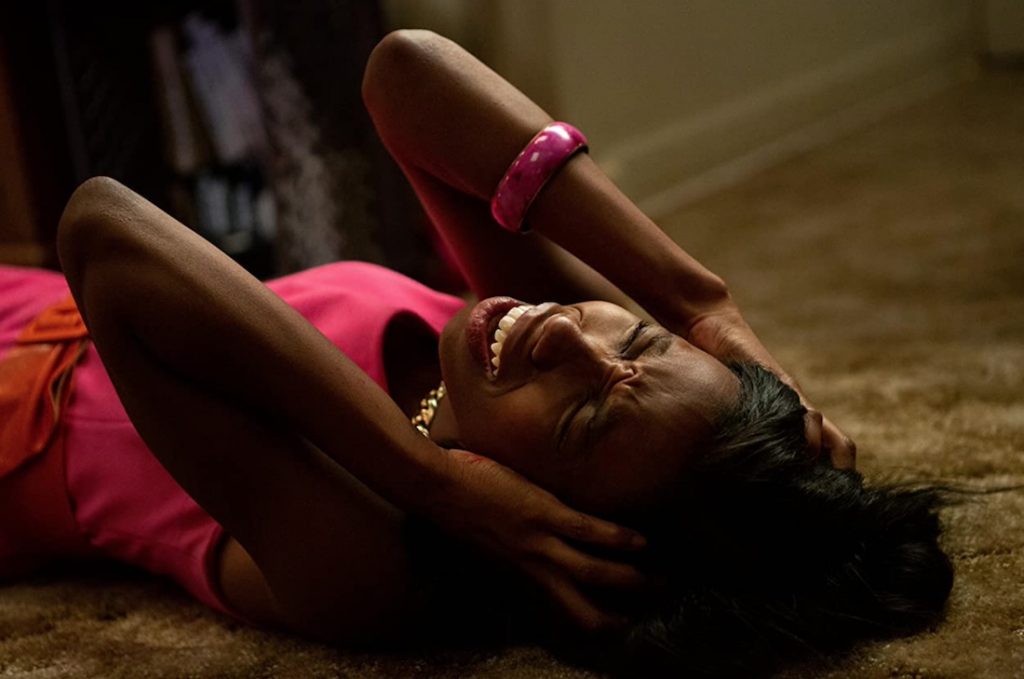
An argument could be made that Bad Hair has its heart in the right place and Simien should be commended for highlighting the stigma of black hair to a wider audience. Unfortunately, I believe a male voice is a wrong choice to shape a cultural understanding of a female’s experience. Hemamset Angaza’s documentary In Our Heads About Our Hair (2012) and Haifaa al-Mansour’s Nappily Ever After (2018) reflect a women’s perspective masterfully. Admittedly, Bad Hair won’t resolve the stigmas surrounding the unfair discrimination of black people’s hair. However, Simien’s poignant message will encourage audiences to understand the experiences of black women who are treated differently because of their hair.
Overall, Bad Hair is at its best when it fully leans into the ridiculousness of its own premise. Similar to Dear White People, Simien has created a camp horror that will definitely create conversation. Despite several portions being weighted down with pacing issues, Bad Hair remains stylish and witty. The director lovingly pays homage to classic B Movies like Little Shop of Horrors (1986) and Invasion of the Body Snatchers. Although one would argue Simien struggles to relate to the female’s perspective, his efforts are valiant and unique. He demonstrates how the most effective horrors are a reflection of the true horrors that humans bring upon themselves.
If you enjoyed this review, support my writing and buy me a coffee.
USA | 2020 | 102 MINUTES | 1.85:1 | COLOUR | ENGLISH

writer & director: Justin Simien.
starring: Elle Lorraine, Jay Pharaoh, Lena Waithe, Kelly Rowland, Laverne Cox, Chanté Adams, James Van Der Beek, Usher Raymond IV, Blair Underwood & Vanessa Williams.
